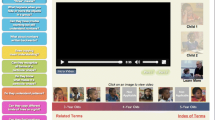Abstract
In an effort to determine the most efficacious manner to deliver professional development training to early childhood educators, this study investigated the effect of a 2-h workshop followed by side-by-side classroom coaching. Twelve early childhood educators with 4-year degrees teaching in a university child development center participated in the study. The twice weekly classroom observations were analyzed for the use of math mediated language. Results indicate a 56% increase of math mediated language following the professional development; however, the greatest increase (39% increase over professional development condition) occurred during the side-by-side coaching phase of the treatment. These results corroborate previous findings that implementation of teaching strategies presented in professional development trainings can be enhanced by coaching teachers on the use of the strategies.


Similar content being viewed by others
References
Arnett, J. (1989). Caregivers in day-care centers: Does training matter? Journal of Applied Developmental Psychology, 10, 541–552. doi:10.1016/0193-3973(89)90026-9.
Baroody, A. J. (1987). Children’s mathematical thinking: A developmental framework for preschool, primary, and special education teachers. New York: Teachers College, Columbia University.
Baroody, A. J. (2004). The role of psychological research in the development of early childhood mathematics standards. In D. H. Clements & J. Sarama (Eds.), Engaging young children in mathematics: Standards for early childhood mathematics instruction (pp. 149–172). Mahwah, NJ: Lawrence Erlbaum Associates.
Burchinal, M. R., Cryer, D., Clifford, R. M., & Howes, C. (2002). Caregiver training and classroom quality in child care centers. Applied Developmental Science, 6(1), 2–11. doi:10.1207/S1532480XADS0601_01.
Clements, D. H. (2004a). Major themes and recommendations. In D. H. Clements & J. Sarama (Eds.), Engaging young children in mathematics: Standards for Early childhood mathematics instruction (pp. 7–72). Mahwah, NJ: Lawrence Erlbaum Associates.
Clements, D. H. (2004b). Geometric and spatial thinking in early childhood education. In D. H. Clements & J. Sarama (Eds.), Engaging young children in mathematics: Standards for Early childhood mathematics instruction (pp. 267–298). Mahwah, NJ: Lawrence Erlbaum Associates.
Collins, D., Gabor, P., & Ing, C. (1987). Communication skill training in child care: The effects of preservice and inservice training. Child Youth Care Quarterly, 16(2), 106–115. doi:10.1007/BF01083975.
Copley, J. V. (2000). The young child and mathematics. Washington, DC: National Association for the Education of Young Children.
Fiene, R. (2002). Improving child care quality through an infant caregiver mentoring project. Child and Youth Care Forum, 31(2), 79–87. doi:10.1023/A:1015318501688.
Ginsburg, H. P. (1989). Children’s arithmetic: How they learn it and how you teach it. Austin, TX: Pro-Ed.
Harms, T., Cryer, D., & Clifford, R. (1990). Infant-toddler environmental rating scale. New York: Teachers College Press.
Hendrickson, J. M., Gardner, N., Kaiser, A., & Riley, A. (1993). Evaluation of a social interaction coaching program in an integrated day-care setting. Journal of Applied Behavior Analysis, 26, 213–225. doi:10.1901/jaba.1993.26-213.
Hendrickson J. M., Stroka K., & Gable R. (1989). Peer coaching: A specific approach for improving teacher performance and trainee competency (ERIC Document Reproduction Service No. ED 321:207).
Howes, C. (1983). Caregiver behavior in center and family day care. Journal of Applied Developmental Psychology, 4, 99–107. doi:10.1016/0193-3973(83)90061-8.
Howes, C. (1997). Children’s experiences in center-based child care as a function of teacher background and adult: child ratio. Merrill-Palmer Quarterly, 43, 404–425.
Howes, C., Smith, E., & Galinsky, E. (1995). The Florida child quality improvement study: Interim report. New York: Families and Work Institute.
Kamii, C., & Anderson, C. (2003). Multiplication games: How we made and used them. Teaching Children Mathematics, 10(3), 135–141.
Kruif, R. E. L., McWilliams, R. A., Ridley, S. M., & Wakely, M. B. (2000). Classification of teachers’ interaction behaviors in early childhood classrooms. Early Childhood Research Quarterly, 15(2), 247–268. doi:10.1016/S0885-2006(00)00051-X.
Miller, S. P., Harris, C., & Watanabe, A. (1991). Professional coaching: A method for increasing effective and decreasing ineffective teacher behaviors. Teacher Education and Special Education, 14, 183–191.
Rubenstein, R. N., & Thompson, D. R. (2002). Understanding and supporting children’s mathematical vocabulary development. Teaching Children Mathematics, 9(2), 107–112.
Rudd L. C., Cain D. W., & Saxon T. F. (2008). Does improving joint attention in low quality child care enhance language development? Early Child Development and Care, 178(3), 315–338.
Rudd L. C., Cain D. W., Wilder P. H., Saxon T. F., Myers A. E., & Menninger S. E. (2009). Coaching early childhood educators in high quality centers through the use of Focus-Follow-Talk procedures Early Child Development and Care (under review).
Seo, K. H., & Ginsberg, H. P. (2004). What is developmentally appropriate in early childhood mathematics education? Lessons from new research. In D. H. Clements & J. Sarama (Eds.), Engaging young children in mathematics: Standards for Early childhood mathematics instruction (pp. 91–104). Mahwah, NJ: Lawrence Erlbaum Associates.
Whitin, D. J., & Whitin, P. (2003). Talk counts. Teaching Children Mathematics, 10, 142–149.
Author information
Authors and Affiliations
Corresponding author
Rights and permissions
About this article
Cite this article
Rudd, L.C., Lambert, M.C., Satterwhite, M. et al. Professional Development + Coaching = Enhanced Teaching: Increasing Usage of Math Mediated Language in Preschool Classrooms. Early Childhood Educ J 37, 63–69 (2009). https://doi.org/10.1007/s10643-009-0320-5
Received:
Accepted:
Published:
Issue Date:
DOI: https://doi.org/10.1007/s10643-009-0320-5




